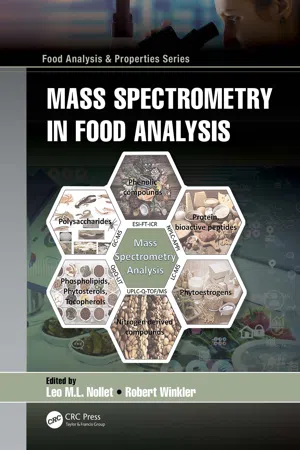
Mass Spectrometry in Food Analysis
- 442 pages
- English
- ePUB (mobile friendly)
- Available on iOS & Android
Mass Spectrometry in Food Analysis
About This Book
The quality and safety of food are crucial for human nutrition. However, evaluating the chemical composition of food is challenging for the analyst and requires powerful methods. Chromatography and mass spectrometry (MS) is the gold standard for analyzing complex food samples, including raw materials and intermediate and finished products.
Mass Spectrometry in Food Analysis covers the MS-based analysis of different aspects of food quality, which include nutritional value, profile of macronutrients (proteins, lipids, and carbohydrates), micronutrients (vitamins), and nutraceutical active compounds. Additionally, sensory quality, flavor, food pigments, safety, and detection of pesticides, contact materials, veterinary drugs and pharmaceuticals, organic pollutants, and pathogens are covered.
Key Features:
-
- Contains the basics of mass spectrometry and experimental strategies
-
- Explores determination of macro- and micronutrients
-
- Analyzes sensory and nutraceutical food quality
-
- Discusses detection of contaminants and proof of authenticity
-
- Presents emerging methods for food analysis
This book contains an introductory section that explains the basics of MS and the difference between targeted and untargeted strategies for beginners. Further, it points out new analytical challenges, such as monitoring contaminants of emerging concern, and presents innovative techniques (e.g., ambient ionization MS and data mining).
Also available in the Food Analysis & Properties Series:
Nanoemulsions in Food Technology: Development, Characterization, and Applications, edited by Javed Ahmad and Leo M.L. Nollet (ISBN: 978-0-367-61492-8)
Sequencing Technologies in Microbial Food Safety and Quality, edited by Devarajan Thangadurai, Leo M.L. Nollet, Saher Islam, and Jeyabalan Sangeetha (ISBN: 978-0-367-35118-2)
Chiral Organic Pollutants: Monitoring and Characterization in Food and the Environment, edited by Edmond Sanganyado, Basil K. Munjanja, and Leo M.L. Nollet (ISBN: 978-0-367-42923-2)
For a complete list of books in this series, please visit our website at:
www.crcpress.com/Food-Analysis--Properties/book-series/CRCFOODANPRO
Frequently asked questions
Information
Section 1 Mass Spectrometry – Theoretics
1 Basic Principles and Fundamental Aspects of Mass Spectrometry
Contents
- 1.1 Introduction
- 1.2 Principle of Mass Spectrometry
- 1.3 Instrumentation of Mass Spectrometry
- 1.3.1 Ionization Techniques
- 1.3.1.1 Gas Phase
- 1.3.1.2 Desorption Phase
- 1.3.2 Mass Analyzers
- 1.3.2.1 Time-of-Flight
- 1.3.2.2 Quadrupole
- 1.3.2.3 Orbitrap Mass Analyzer
- 1.3.2.4 Fourier Transform–Ion Cyclotron Resistance
- 1.3.2.5 Tandem Mass Analyzer
- 1.3.3 Mass Detectors
- 1.3.3.1 Electron Multiplier
- 1.3.3.2 Faraday Cup
- 1.3.3.3 Photomultipliers
- 1.3.1 Ionization Techniques
- 1.4 Interpretation of Mass Spectra
- 1.4.1 Types of Peaks in Mass Spectroscopy
- 1.4.2 Fragmentation Rules
- 1.5 Application of Mass Spectrometry
- 1.5.1 Qualitative Applications
- 1.5.1.1 Determination of Molecular Weight
- 1.5.1.2 Determination of the Molecular Formula
- 1.5.1.3 Determination of the Partial Molecular Formula
- 1.5.1.4 Determination of the Compound Structure
- 1.5.2 Quantitative Applications
- 1.5.2.1 Isotope Abundance Assessment
- 1.5.2.2 Determination of Isotope Ratio
- 1.5.2.3 Differentiation between cis-Isomers and trans-Isomers
- 1.5.2.4 Mass Spectrometry in Thermodynamics
- 1.5.2.5 Measurement of Ionization Potential
- 1.5.2.6 Determination of Ion–Molecule Reactions
- 1.5.2.7 Detection and Identification of Impurity
- 1.5.2.8 Identification of Unknown Compounds
- 1.5.3 Both Qualitative and Quantitative Applications
- 1.5.3.1 Phytochemical Analysis
- 1.5.3.2 Structural Elucidation of Unknown Phytochemicals
- 1.5.3.3 Drug Metabolism Studies
- 1.5.3.4 Clinical Studies
- 1.5.3.5 Forensic Applications
- 1.5.1 Qualitative Applications
- 1.6 Conclusion
- References
1.1 Introduction
1.2 Principle of Mass Spectrometry
1.3 Instrumentation of Mass Spectrometry

1.3.1 Ionization Techniques
| Ionization Mode | Nature | Sample | Range of Mass | Description |
|---|---|---|---|---|
| Electron impact (EI) | Volatile: thermally stable | GC solid or liquid probe | <1,100 Da | Hard method; mainly fragmented ions |
| Chemical ionization (CI) | Volatile: thermally stable | GC solid or liquid probe | <1,000 Da | Soft method; molecular ion |
| Fast-atom bombardment (FAB) | Organometallic compounds | LC direct injection | <5,200 Da; optimal range 250–2,000 | Soft method; require matrix |
| Matrix-assisted laser desorption ionization (MALDI) | Proteomics, genomics | Sample is... |
Table of contents
- Cover
- Half Title Page
- Series Page
- Title Page
- Copyright Page
- Table of Contents
- Series Preface
- Preface
- Editors
- Contributors
- Section 1 Mass Spectrometry – Theoretics
- Section 2 MS Analysis of Food Components
- Section 3 MS Analysis of Residues
- Section 4 MS Analysis in Food Authentication
- Section 5 Emerging Fields
- Index